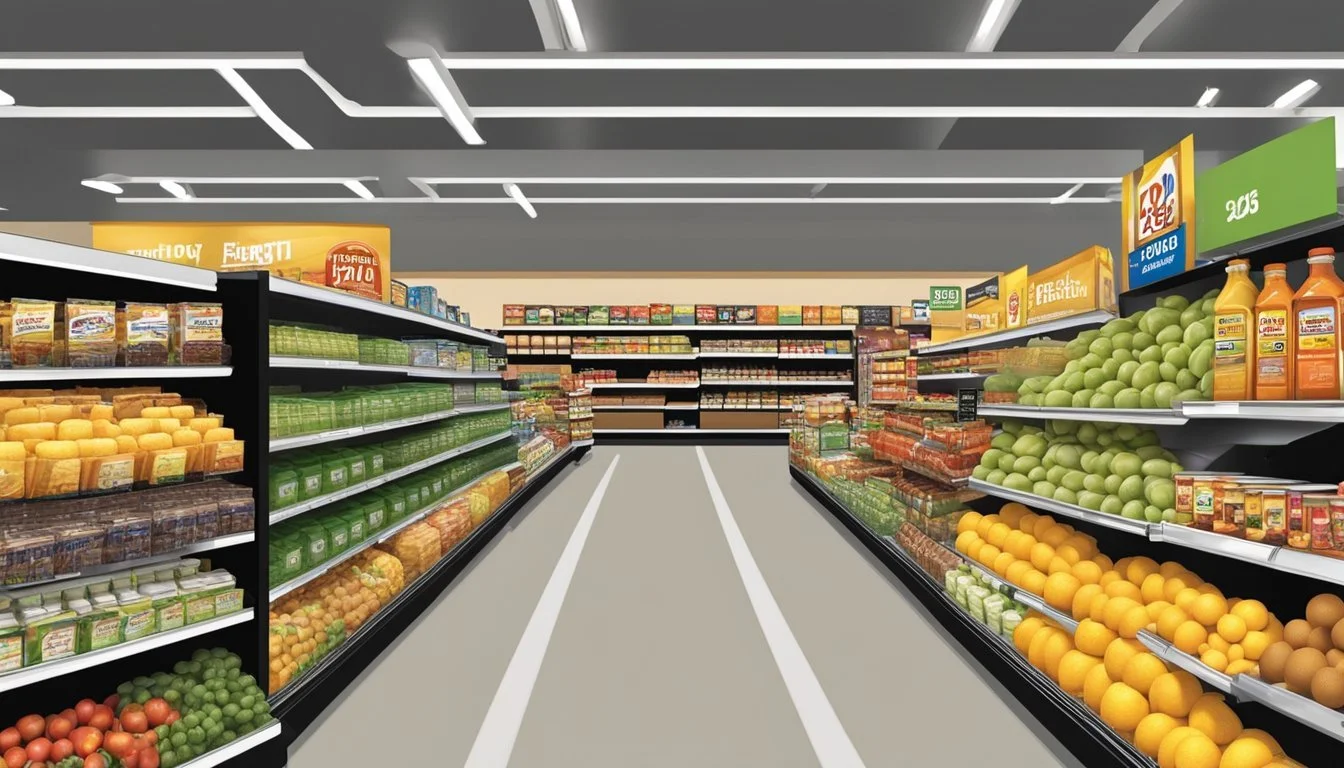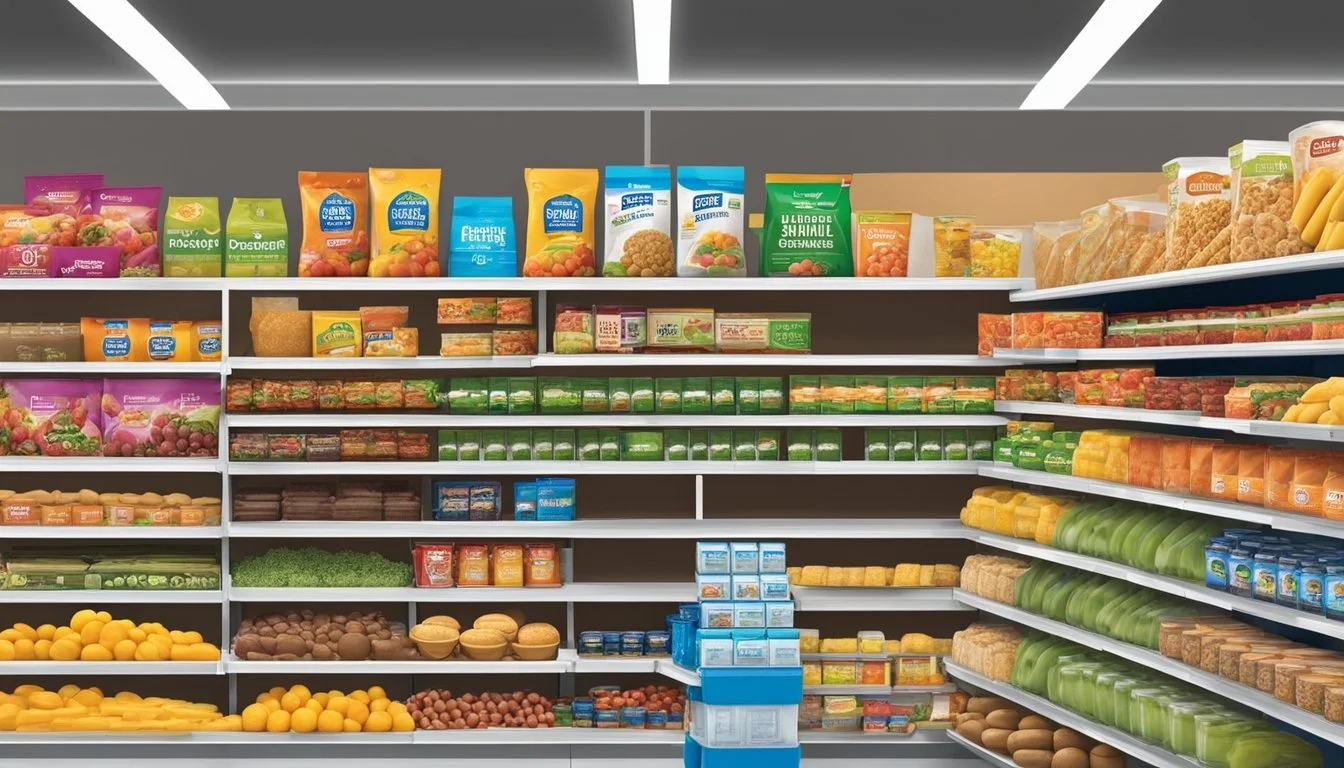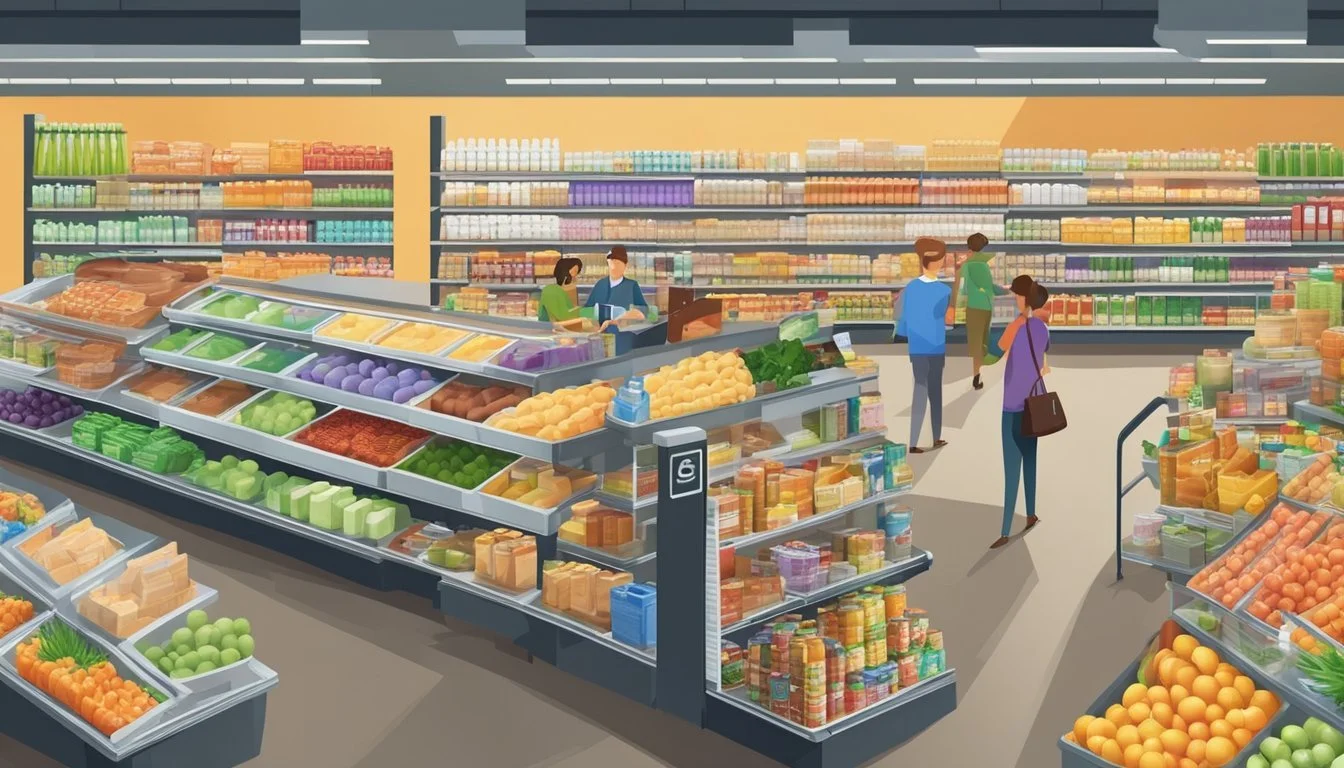Food Lion vs Grocery Outlet
Comparing Prices, Quality, and Selection
Food Lion and Grocery Outlet are two popular grocery chains known for offering competitive prices. Both stores aim to provide value to shoppers looking to stretch their budgets in an era of rising food costs.
Food Lion edges out Grocery Outlet in overall value, offering prices about 10% below average compared to Grocery Outlet's 20% below average. However, Grocery Outlet's unique model of selling surplus and closeout items can lead to deeper discounts on specific products.
Shoppers seeking consistent low prices across a wide selection may prefer Food Lion. Those willing to hunt for deals and don't mind a changing inventory might find bigger savings at Grocery Outlet. The best choice depends on individual shopping habits and preferences.
Company Overviews
Food Lion and Grocery Outlet are two distinct players in the grocery retail sector, each with its own unique history and business approach. Both companies have carved out their niches in the competitive supermarket landscape.
History of Food Lion
Food Lion began as Food Town in 1957 in Salisbury, North Carolina. Founded by Ralph Ketner, Brown Ketner, and Wilson Smith, the company initially operated a single store. In 1983, the name changed to Food Lion to avoid confusion with other similarly named chains.
Food Lion expanded rapidly throughout the southeastern United States in the 1980s and 1990s. The company's low-price strategy and efficient operations fueled its growth. By the early 2000s, Food Lion had over 1,200 stores across 11 states.
In 2016, Food Lion became part of Ahold Delhaize, a Dutch-Belgian retail company. This merger strengthened Food Lion's position in the market and provided access to additional resources for further expansion and improvement.
History of Grocery Outlet
Grocery Outlet's story began in 1946 when Jim Read started selling military surplus at deep discounts in San Francisco. The company, initially called Cannery Sales, focused on selling excess inventory from canneries and other food producers.
In the 1970s, Jim's son Steven Read took over and expanded the business. The company rebranded as Grocery Outlet in 1987, emphasizing its focus on offering significant discounts on groceries.
Grocery Outlet's unique model of selling overstock and closeout items at steep discounts proved successful. The company grew steadily, expanding beyond California into other western states and later across the country.
In 2019, Grocery Outlet went public, listing on the NASDAQ stock exchange. This move provided additional capital for further expansion and solidified its position as a major player in the discount grocery sector.
Unique Business Models
Food Lion operates as a traditional supermarket chain with a focus on everyday low prices. The company emphasizes fresh produce, meat, and dairy products alongside a wide range of grocery items. Food Lion's stores are typically medium-sized and located in both urban and rural areas.
Key features of Food Lion's model include:
MVP loyalty program offering personalized discounts
Focus on local products and community involvement
Regular weekly specials and promotions
Grocery Outlet, in contrast, employs an opportunistic buying model. The company purchases excess inventory, discontinued items, and closeouts from manufacturers at deep discounts. These savings are then passed on to customers.
Grocery Outlet's unique aspects include:
Independent operator model, with local owners running each store
Constantly changing inventory based on available deals
"Treasure hunt" shopping experience with new finds each visit
Both chains prioritize value for customers but achieve this through different strategies and store formats.
Store Atmosphere and Layout
Food Lion and Grocery Outlet offer distinct shopping experiences through their store designs and organizational approaches. These elements significantly impact customer comfort and convenience while navigating the aisles.
Navigating the Aisles
Food Lion typically employs a grid layout, with clearly defined aisles and departments. This traditional approach allows for easy navigation and product location. Signs above each aisle list the main categories found there, helping shoppers quickly find what they need.
Grocery Outlet, on the other hand, often uses a more varied layout. Their stores may incorporate a mix of grid patterns and free-flow areas. This design can create a 'treasure hunt' atmosphere, encouraging shoppers to explore and discover unexpected deals.
Both stores generally place essential items like dairy and produce along the perimeter. This strategy encourages customers to walk through more of the store, potentially increasing impulse purchases.
Cleanliness and Organization
Food Lion emphasizes cleanliness in its stores. Floors are typically well-maintained, and shelves are regularly restocked and organized. The chain invests in bright lighting to create a clean, welcoming atmosphere.
Grocery Outlet stores may vary more in terms of cleanliness and organization. As a discount retailer, some locations might have a more 'no-frills' appearance. Products are often displayed in their original shipping boxes to reduce costs and labor.
Both chains prioritize food safety and hygiene standards. However, Food Lion's more uniform approach across stores can lead to a more consistent experience for shoppers in terms of cleanliness and organization.
Product Variety and Availability
Food Lion and Grocery Outlet differ significantly in their product offerings and availability. These differences impact customer shopping experiences and preferences.
Breadth of Options
Food Lion provides a wide range of products, including national brands and store-brand items. Their shelves typically stock over 10,000 different products. Grocery Outlet, on the other hand, offers a more limited selection, focusing on discounted and overstock items. Their inventory changes frequently, with about 4,000-6,000 products available at any given time.
Food Lion's consistent stock allows customers to find familiar items on each visit. Grocery Outlet's rotating inventory creates a "treasure hunt" shopping experience.
Quality of Produce
Food Lion maintains a steady supply of fresh produce, with a mix of conventional and organic options. They source from local farms when possible, ensuring freshness.
Grocery Outlet's produce section varies in size and quality. They often offer deeply discounted fruits and vegetables, but availability can be inconsistent.
Both stores implement quality control measures, but Food Lion generally provides more reliable produce quality due to their consistent supply chain.
Meat and Dairy Offerings
Food Lion offers a full-service meat department with fresh cuts, poultry, and seafood. Their dairy section includes a wide variety of milk, cheese, and yogurt options from both national and store brands.
Grocery Outlet's meat and dairy selections are more limited. They often feature discounted packaged meats and dairy products close to their expiration dates. While this results in lower prices, the selection may not be as comprehensive or consistent as Food Lion's.
Specialty and Organic Products
Food Lion has expanded its organic and specialty product lines in recent years. They now offer a substantial selection of organic produce, gluten-free items, and international foods.
Grocery Outlet occasionally stocks organic and specialty products at discounted prices. However, their selection is less predictable and may not cater to specific dietary needs consistently.
Food Lion's Nature's Promise store brand includes over 1,500 organic and natural items. Grocery Outlet doesn't have a dedicated organic store brand but often features discounted organic products from various brands.
Pricing and Value for Money
Food Lion and Grocery Outlet both offer competitive pricing, but their strategies differ. Each store provides unique ways for customers to save money on groceries through various promotions and product offerings.
Comparison of Everyday Prices
Food Lion maintains consistently low prices on everyday items. Their "Low Price Heritage" campaign ensures staple products remain affordable.
Grocery Outlet, as a discount store, often beats Food Lion's prices on many items. Their business model of selling overstock and closeout merchandise allows for deeper discounts.
A typical grocery basket at Grocery Outlet can be 10-20% cheaper than at Food Lion. However, product availability at Grocery Outlet can be inconsistent due to their sourcing methods.
Deals and Weekly Specials
Food Lion offers weekly specials advertised in circulars and their mobile app. These deals usually include a mix of produce, meat, and pantry items.
Grocery Outlet's deals change more frequently, sometimes daily. They often have "NOSH" (Natural, Organic, Specialty, Healthy) items at significant discounts.
Both stores provide opportunities for substantial savings, but Grocery Outlet's deals tend to be more dramatic, sometimes up to 70% off retail prices.
Store Brands vs. Name Brands
Food Lion's store brand, "Nature's Promise," offers organic and natural products at lower prices than national brands. Their "Taste of Inspirations" line provides premium products at competitive prices.
Grocery Outlet primarily sells name brands at discounted prices. They occasionally offer lesser-known brands or discontinued products at steep discounts.
For budget-conscious shoppers, Food Lion's store brands provide consistent value. Grocery Outlet excels in offering name brands at prices comparable to or lower than typical store brands.
Discount and Loyalty Programs
Food Lion's "MVP" loyalty program offers personalized coupons and rewards based on shopping habits. Members can save up to $20 per week through targeted offers.
Grocery Outlet doesn't have a traditional loyalty program. Instead, they rely on their overall low prices and rotating inventory to attract repeat customers.
Food Lion's program provides more predictable savings for regular shoppers. Grocery Outlet's approach appeals to bargain hunters who enjoy the "treasure hunt" experience of finding unexpected deals.
Shopping Experience
The shopping experience at Food Lion and Grocery Outlet differs significantly in several key areas. These include the level of customer service, efficiency of checkout processes, and overall store accessibility.
Customer Service and Staff Friendliness
Food Lion emphasizes customer service training for its employees. Staff members are generally knowledgeable about product locations and can assist with specific inquiries. They often greet customers and maintain a friendly demeanor throughout the store.
Grocery Outlet takes a different approach. As an independently owned franchise model, customer service can vary between locations. Some stores offer personalized attention, while others may have less interaction between staff and customers.
Both chains prioritize cleanliness and organization, though Food Lion typically maintains a more consistent standard across its stores.
Checkout Efficiency
Food Lion invests in technology to streamline the checkout process. Many locations offer self-checkout options alongside traditional cashier lanes. Wait times are generally short, even during peak hours.
Grocery Outlet stores often have fewer checkout lanes. This can lead to longer wait times during busy periods. However, the smaller store format means customers usually have shorter distances to travel from aisles to registers.
Both stores accept various payment methods, including cash, credit cards, and mobile payments. Food Lion's loyalty program integrates with checkout systems for seamless discount application.
Store Accessibility
Food Lion stores are typically located in both urban and suburban areas. Their layout is designed for easy navigation, with wide aisles and clear signage. Most stores offer ample parking and are wheelchair accessible.
Grocery Outlet locations are often found in strip malls or standalone buildings. Store sizes can vary, but they generally have a more compact layout. This can make navigation quicker but may feel cramped during busy times.
Both chains strive to place stores in convenient locations for their target demographics. Food Lion focuses on neighborhood accessibility, while Grocery Outlet often chooses areas with lower real estate costs to maintain their discount model.
Consumer Perception and Brand Reputation
Food Lion and Grocery Outlet have distinct reputations among shoppers. Their customer ratings, market positions, and brand loyalty shape how consumers view these grocery chains.
Customer Ratings and Reviews
Food Lion receives positive feedback from many customers. In a recent survey, Food Lion earned a Knoji score of 4.3 out of 5 from 72 ratings. This indicates generally satisfied shoppers.
Consumers often praise Food Lion for its cleanliness and attentive employees. A Consumer Reports survey assessed grocery stores on 13 attributes, including these factors.
Grocery Outlet's ratings are more mixed. Some shoppers appreciate its discount prices, while others note limited selection compared to traditional supermarkets.
Market Position and Brand Loyalty
Food Lion operates about 1,100 stores across 10 states, employing around 60,000 associates. This regional focus allows Food Lion to tailor its offerings to local preferences.
Food Lion competes effectively against larger chains like Kroger in its market areas. It also faces competition from discount grocers like ALDI and Lidl.
Grocery Outlet positions itself as a bargain retailer, appealing to price-conscious shoppers. Its "treasure hunt" shopping experience, with constantly changing inventory, creates a unique draw for some customers.
Both chains work to build loyalty through rewards programs and community involvement. Food Lion's MVP Card and Grocery Outlet's WOW Rewards offer personalized savings to frequent shoppers.
Comparison to Other Retailers
Food Lion and Grocery Outlet face competition from numerous national and regional grocery chains. Each retailer offers unique advantages and disadvantages compared to these two stores.
Market Competitors
Walmart stands out as a major competitor, offering prices about 17% lower than average. Aldi and Lidl compete on price and efficiency with their no-frills approach. Kroger, operating over 2,700 stores nationwide, brings scale and diverse offerings. Regional players like Publix in the Southeast and H-E-B in Texas provide strong local competition.
Wegmans and Whole Foods target higher-end consumers with premium products and shopping experiences. Trader Joe's carves out a niche with unique private-label items. Costco and Sam's Club offer bulk purchases for additional savings.
Alternative Shopping Venues
Online retailers like Amazon Fresh and Instacart have changed the grocery landscape. These services offer convenience but often at higher prices than traditional stores. Farmers markets provide fresh, local produce but may have limited hours and selection.
Discount stores like Dollar General and Family Dollar increasingly stock grocery items. These stores offer competitive prices on a limited range of products. Convenience stores provide quick shopping options but typically charge premium prices.
Drug stores like CVS and Walgreens have expanded their grocery sections, offering another alternative for basic items. However, their prices are generally higher than dedicated grocery stores.
Strategic Outlook
Food Lion and Grocery Outlet are adapting to changing market dynamics while pursuing growth strategies. Both grocers are focusing on innovation and expansion to strengthen their positions in the competitive retail landscape.
Adaptation and Innovation
Food Lion has invested heavily in store remodels and digital initiatives. The grocer has enhanced its mobile app and e-commerce capabilities to meet evolving consumer preferences. Researchers note Food Lion's emphasis on fresh produce and local sourcing as key differentiators.
Grocery Outlet maintains its unique opportunistic buying model. The company leverages its network of independent operators to quickly adapt to local market needs. Grocery Outlet has also expanded its natural and organic offerings to appeal to health-conscious shoppers.
Expansion and Growth Plans
Food Lion continues to focus on its core Mid-Atlantic and Southeast markets. The grocer plans to open new stores and acquire strategic locations to densify its presence. Food Lion's parent company, Ahold Delhaize, provides financial backing for these expansion efforts.
Grocery Outlet is pursuing aggressive growth in new and existing markets. The company aims to expand its store count by 10% annually. Grocery Outlet's entry into new states like New Jersey and its first Las Vegas location demonstrate its commitment to geographic expansion.
Both retailers are exploring smaller-format stores to penetrate urban areas and underserved communities. This strategy allows them to reach new customer segments and compete with convenience stores.








